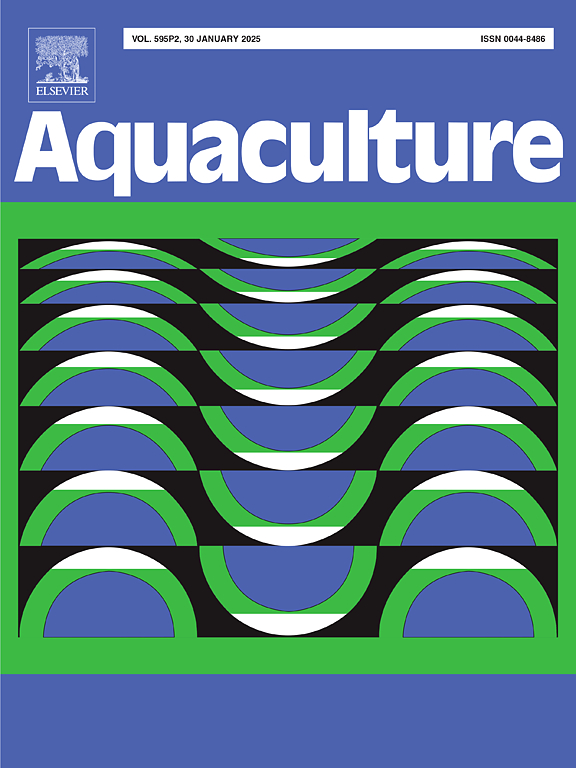Recirculating aquaculture mode has high sustainability and environmental accommodation capacity via better energy-saving and water-saving effects in Cynoglossus semilaevis production
IF 3.9
1区 农林科学
Q1 FISHERIES
引用次数: 0
Abstract
Recirculating aquaculture mode is a promising direction for future aquaculture development due to its energy, water, and land-saving advantages, high efficiency, and lack of seasonal restrictions. This study evaluated and compared the economic efficiency and environmental sustainability of Cynoglossus semilaevis production in flow-through and recirculating aquaculture modes using the economic methodology and the emergy analysis method. The results showed that: 1) The fixed investment cost for the recirculating aquaculture system was 2.188 times as that of the flow-through aquaculture system. 2) The recirculating water aquaculture mode saved 54.55 % of electricity, 93 % of coal, and 95 % of water compared with the flow-through aquaculture mode. 3) The recirculating aquaculture mode performed better in all breeding parameters than the flow-through aquaculture mode. In addition, the yield, tax revenue, and profit of the recirculating aquaculture system were 1.71 times, 1.71 times, and 2.98 times that of the flow-through aquaculture mode, respectively, and the break-even point was 4.35 %, indicating that the former has better risk resistance ability compared to the latter. 4) For the recirculating aquaculture mode the renewable energy value consumption was only 3.272 % that of the flow-through aquaculture mode, the non-renewable energy value input was 1.59 times that of the flow-through aquaculture mode, and the output energy value was 1.71 times that of the flow-through aquaculture mode. 5) The EIR value of the recirculating aquaculture mode was 48.89 times that of the flow-through aquaculture mode, and the EYR value was 1.069 times that of the flow-through aquaculture mode, which indicated that the recirculating aquaculture mode was less dependent on the environment and had higher production efficiency. 6) The flow-through aquaculture mode used 34.77 % of the environmental energy value input for aquaculture production. However, the uncontrolled use of groundwater and geothermal resources had caused great damage to the environmental ecosystem. To sum up, the recirculating aquaculture mode had higher sustainability and environmental accommodation capacity and could significantly reduce the pressure of aquaculture industry on the environment.
循环水养殖模式在半舌鱼生产中具有较好的节能节水效果,具有较高的可持续性和环境适应能力
循环水养殖模式具有节能、节水、省地、效率高、不受季节限制等优点,是未来水产养殖发展的重要方向。运用经济学方法和能值分析方法,对流动和循环水养殖模式下半舌鱼生产的经济效益和环境可持续性进行了评价和比较。结果表明:1)循环水养殖系统的固定投资成本是直流式养殖系统的2.188倍。2)循环水养殖模式比流水养殖模式节电54.55%,节煤93%,节水95%。3)循环水养殖模式在各项养殖参数上均优于流水养殖模式。此外,循环水养殖系统的产量、税收和利润分别是流通式养殖模式的1.71倍、1.71倍和2.98倍,盈亏平衡点为4.35%,表明循环水养殖系统比流通式养殖模式具有更好的抗风险能力。4)循环水养殖模式的可再生能量值消耗仅为流通式养殖模式的3.272%,不可再生能量值投入是流通式养殖模式的1.59倍,输出能量值是流通式养殖模式的1.71倍。5)循环水养殖模式的EIR值是流通式养殖模式的48.89倍,EYR值是流通式养殖模式的1.069倍,表明循环水养殖模式对环境的依赖性较小,具有较高的生产效率。(6)流通式养殖模式将34.77%的环境能值投入水产养殖生产。然而,地下水和地热资源的不加控制的利用对环境生态系统造成了极大的破坏。综上所述,循环水养殖模式具有更高的可持续性和环境适应能力,可以显著降低水产养殖业对环境的压力。
本文章由计算机程序翻译,如有差异,请以英文原文为准。
求助全文
约1分钟内获得全文
求助全文
来源期刊

Aquaculture
农林科学-海洋与淡水生物学
CiteScore
8.60
自引率
17.80%
发文量
1246
审稿时长
56 days
期刊介绍:
Aquaculture is an international journal for the exploration, improvement and management of all freshwater and marine food resources. It publishes novel and innovative research of world-wide interest on farming of aquatic organisms, which includes finfish, mollusks, crustaceans and aquatic plants for human consumption. Research on ornamentals is not a focus of the Journal. Aquaculture only publishes papers with a clear relevance to improving aquaculture practices or a potential application.
 求助内容:
求助内容: 应助结果提醒方式:
应助结果提醒方式:


